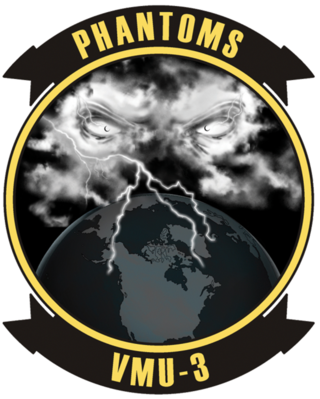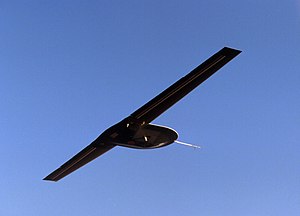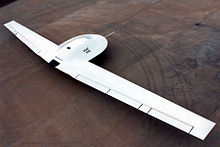
The General Atomics MQ-1 Predator is an American remotely piloted aircraft (RPA) built by General Atomics that was used primarily by the United States Air Force (USAF) and Central Intelligence Agency (CIA). Conceived in the early 1990s for aerial reconnaissance and forward observation roles, the Predator carries cameras and other sensors. It was modified and upgraded to carry and fire two AGM-114 Hellfire missiles or other munitions. The aircraft entered service in 1995, and saw combat in the war in Afghanistan, Pakistan, the NATO intervention in Bosnia, the NATO bombing of Yugoslavia, the Iraq War, Yemen, the 2011 Libyan civil war, the 2014 intervention in Syria, and Somalia.

The Northrop Grumman RQ-4 Global Hawk is a high-altitude, remotely-piloted surveillance aircraft introduced in 2001. It was initially designed by Ryan Aeronautical, and known as Tier II+ during development. The RQ-4 provides a broad overview and systematic surveillance using high-resolution synthetic aperture radar (SAR) and electro-optical/infrared (EO/IR) sensors with long loiter times over target areas. It can survey as much as 40,000 square miles (100,000 km2) of terrain per day, an area the size of South Korea or Iceland.

The AAI RQ-2 Pioneer is an unmanned aerial vehicle (UAV) that had been used by the United States Navy, Marine Corps, and Army, and deployed at sea and on land from 1986 until 2007. Initially tested aboard USS Iowa, the RQ-2 Pioneer was placed aboard Iowa-class battleships to provide gunnery spotting, its mission evolving into reconnaissance and surveillance, primarily for amphibious forces.

The AAI RQ-7 Shadow is an American unmanned aerial vehicle (UAV) used by the United States Army, Australian Army, Swedish Army, Turkish Air Force and Italian Army for reconnaissance, surveillance, target acquisition and battle damage assessment. Launched from a trailer-mounted pneumatic catapult, it is recovered with the aid of arresting gear similar to jets on an aircraft carrier. Its gimbal-mounted, digitally stabilized, liquid nitrogen-cooled electro-optical/infrared (EO/IR) camera relays video in real time via a C-band line-of-sight data link to the ground control station (GCS).

A surveillance aircraft is an aircraft used for surveillance. They are operated by military forces and other government agencies in roles such as intelligence gathering, battlefield surveillance, airspace surveillance, reconnaissance, observation, border patrol and fishery protection. This article concentrates on aircraft used in those roles, rather than for traffic monitoring, law enforcement and similar activities.
Black project is an informal term used to describe a highly classified, top-secret military or defense project that is not publicly acknowledged by government, military personnel or contractors.

The Northrop Grumman MQ-4C Triton is an American high-altitude long endurance unmanned aerial vehicle (UAV) developed for and flown by the United States Navy as a surveillance aircraft. Together with its associated ground control station, it is an unmanned aircraft system (UAS). Developed under the Broad Area Maritime Surveillance (BAMS) program, the Triton is intended to provide real-time intelligence, surveillance and reconnaissance missions (ISR) over vast ocean and coastal regions, continuous maritime surveillance, conduct search and rescue missions, and to complement the Boeing P-8 Poseidon maritime patrol aircraft.

The EADS Barracuda was a jet powered unmanned aerial vehicle (UAV), EADS, used for the role of aerial reconnaissance and also combat. The aircraft is a joint venture between Germany and Spain.

The Lockheed Martin Polecat was an unmanned aerial vehicle by Lockheed Martin. It was developed by the company's Advanced Development Programs division in Palmdale, California.

The BAE Systems Taranis is a British demonstrator programme for unmanned combat aerial vehicle (UCAV) technology, under development primarily by the defence contractor BAE Systems Military Air & Information. The aircraft, which is named after the Celtic god of thunder Taranis, first flew in 2013. An unmanned warplane, the Taranis is designed to fly intercontinental missions, and would carry a variety of weapons, enabling it to attack both aerial and ground targets. It uses stealth technology, giving it a low radar profile, and is controllable via satellite link from anywhere on Earth.

Marine Unmanned Aerial Vehicle Squadron 3 is an unmanned aerial vehicle (UAV) squadron in the United States Marine Corps that operates the MQ-9A Reaper that consists of approximately 200 Marines. They are based out of Marine Corps Base Hawaii, Kaneohe Bay, Hawaii and its primary mission is to provide aerial surveillance for the III Marine Expeditionary Force. The unit also provides Reconnaissance, Surveillance, and Target Acquisition (RSTA) to units participating in Mojave Viper, an exercise held several times a year in 29 Palms, CA. The squadron, nicknamed the Phantoms, was activated on September 12, 2008 and falls under the command of Marine Aircraft Group 24 and the 1st Marine Aircraft Wing.

A high-altitude platform station or atmospheric satellite is a long endurance, high altitude aircraft able to offer observation or communication services similarly to artificial satellites. Mostly unmanned aerial vehicles (UAVs), they remain aloft through atmospheric lift, either aerodynamic like airplanes, or aerostatic like airships or balloons. High-altitude long endurance (HALE) military drones can fly above 60,000 ft over 32 hours, while civil HAPS are radio stations at an altitude of 20 to 50 km above waypoints, for weeks.

Aerial reconnaissance is reconnaissance for a military or strategic purpose that is conducted using reconnaissance aircraft. The role of reconnaissance can fulfil a variety of requirements including artillery spotting, the collection of imagery intelligence, and the observation of enemy maneuvers.

The Lockheed Martin RQ-170 Sentinel, nicknamed Wraith, is an American unmanned aerial vehicle (UAV) developed by Lockheed Martin and operated by the United States Air Force (USAF) for the Central Intelligence Agency (CIA). While the USAF has released few details on the UAV's design or capabilities, defense analysts believe that it is a stealth aircraft fitted with aerial reconnaissance equipment. Introduced in 2007, it was deployed to Afghanistan in late 2007, and to South Korea two years later, in September 2009. Some images and details of the aircraft were released after Iran captured an RQ-170 in 2011. It has a flying wing design, and uses a single engine, speculated to be either a General Electric TF34 turbofan or a Garrett TFE731.

The Lockheed Martin X-56 is an American modular unmanned aerial vehicle that is being designed to explore High-Altitude Long Endurance (HALE) flight technologies for use in future military unmanned reconnaissance aircraft.
The Northrop Grumman RQ-180 is an American stealth unmanned aerial vehicle (UAV) surveillance aircraft intended for contested airspace. As of 2019, there had been no images or statements released, but growing evidence points to the existence of the RQ-180 and its use in regular front-line service. The use of the nickname "White Bat" in a 2021 video released by the US Air Force Profession of Arms Center of Excellence (PACE) suggests that the military may be preparing to release information on the RQ-180.

The Boeing MQ-25 Stingray is an aerial refueling drone that resulted from the Carrier-Based Aerial-Refueling System (CBARS) program, which grew out of the earlier Unmanned Carrier-Launched Airborne Surveillance and Strike (UCLASS) program. The MQ-25 first flew on 19 September 2019.

The Lockheed Martin X-44A is an unmanned aerial vehicle (UAV) technology demonstrator built by the Lockheed Martin Skunk Works.



















